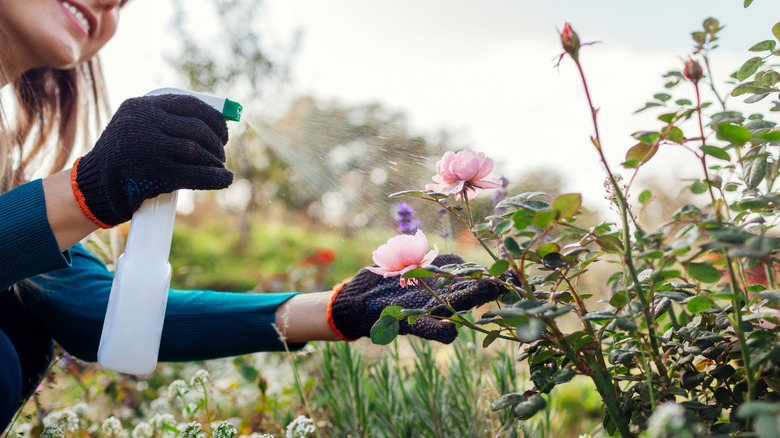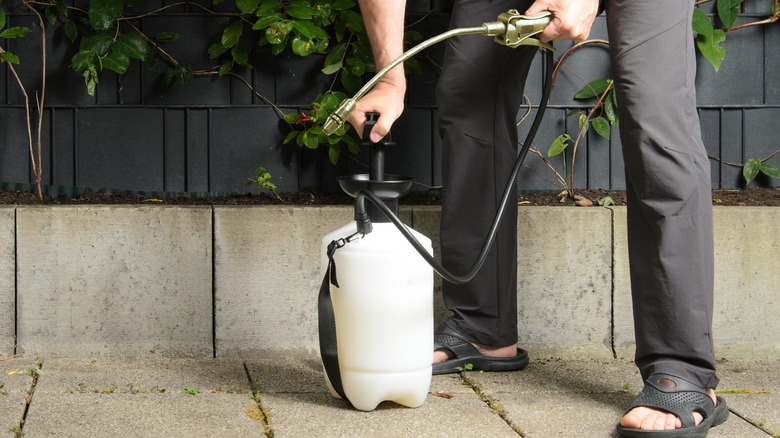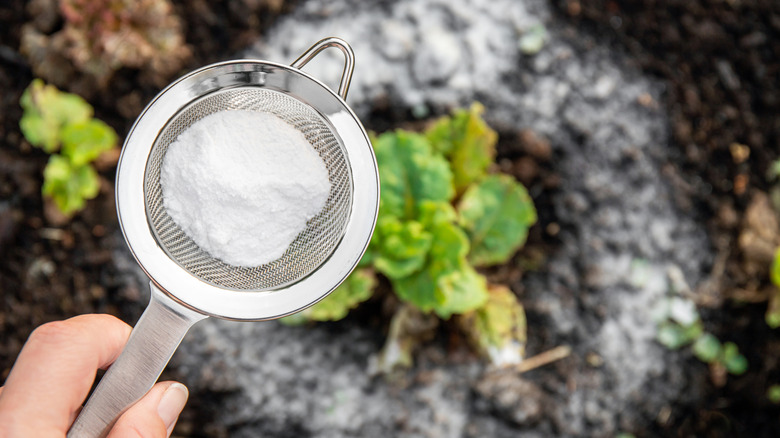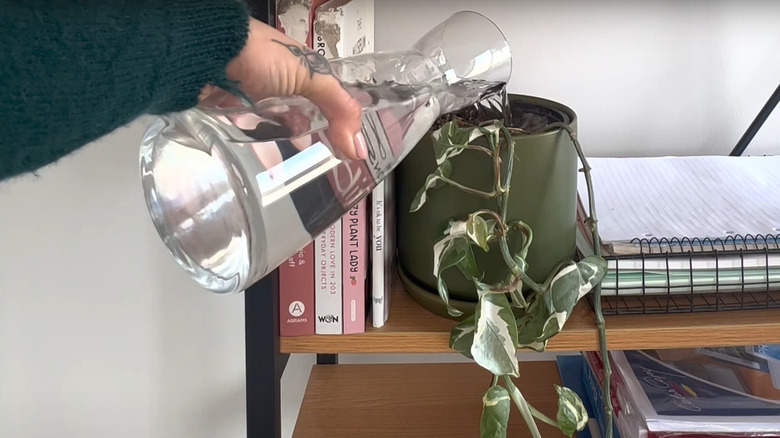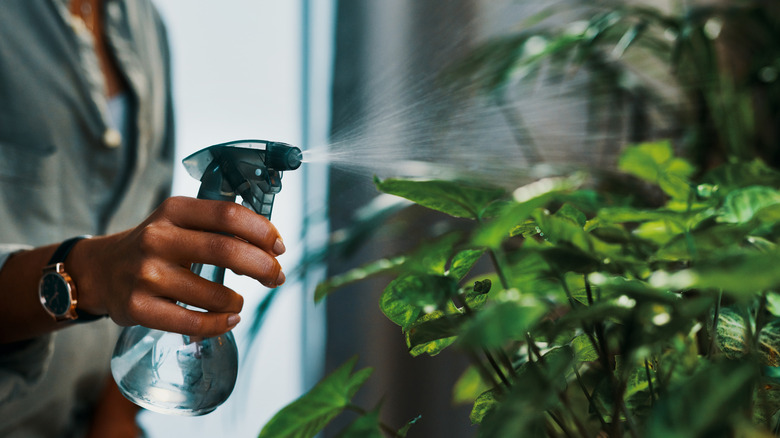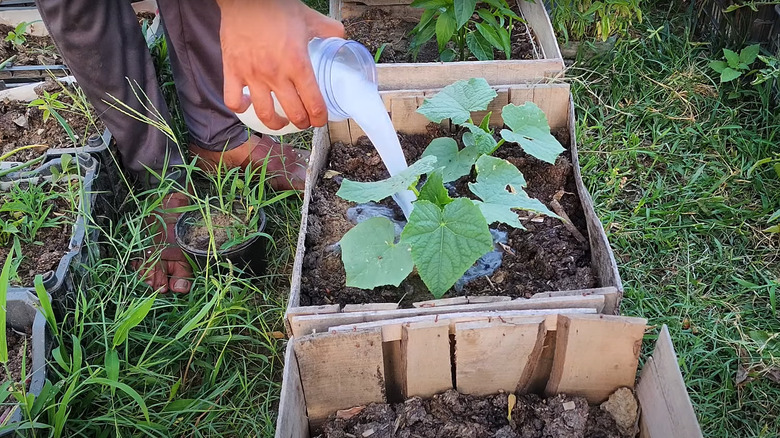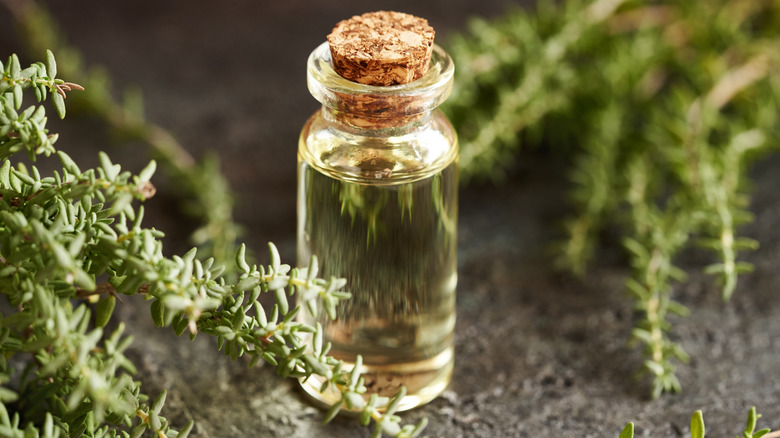Natural Alternatives To Store-Bought Fungicide
We may receive a commission on purchases made from links.
Growing any living plants — whether they're climbers, creepers, herbs, trees, or shrubs — is a science as much as it is an art. Different species have different needs, strengths, and weaknesses, but there's one common issue you'll come up against: Most plants are susceptible to fungal issues. According to Michigan State University, around 85% of plant diseases are caused by fungal growths, making it imperative to do all you can to prevent and treat a fungi problem promptly.
Many people default to commercial fungicides, and while these can be effective and convenient, before you fall back on a store-bought synthetic product, there are some natural and homemade solutions you can try. With the right natural fungicide you can target fungal diseases, and not worry about exposing yourself or your garden to potent chemicals with long, complicated names. Many natural fungicide ingredients break down in soil without having any severe detrimental effects, and while you need to exercise caution when handling some of them, they're not associated with long-term health risks.
Below are seven fungicide ingredients you can DIY at home to target specific fungal issues. Learn more about what these ingredients are and what makes them effective for eliminating fungal disease, while also educating yourself on how to apply them effectively. By the end of this article, you will be able to fight fungi with this array of time-tested homemade solutions.
Sulfur fights fungal disease by disrupting fungi's metabolic processes
Sulfur is a naturally occurring element that's also one of the most important macronutrients for plants. It helps foliage create the chlorophyll needed to photosynthesize, making this nutrient vital for plant health and survival. It's an element that occurs in everything from food to plants, soil, and water. Sulfur is considered to be one of the world's oldest fungicides, and humans have been using it to fight powdery mildew since the 1800s. Sulfur can kill fungi on contact by disrupting the fungi's metabolic processes and its ability to spread. You can apply sulfur to most types of plants, including many fruit and nut trees, berry bushes, vegetable plants, ornamental flowers, and even grasses.
Sulfur-based fungicides are sold at popular retailers like Lowe's, Tractor Supply, and Walmart. However you can also purchase practically pure sulfur, either in powered form or crystals. If you buy the crystals, you will need to crush them up with something like a mortar and pestle, or by placing the sulfur rocks in a plastic bag and hammering them to create a fine powder. If you want to skip all this, the most convenient type of sulfur to buy is the powdered form. Look for products that also contain a wetting agent, like the Bonide Sulfur Plant Fungicide, which contains 90% sulfur, or the I Must Garden Dusting Wettable Sulfur Powder.
You can sprinkle the powder directly over plant leaves and stems, or mix up to 3 tablespoons for every 1 gallon of water (be sure to check the label on wettable sulfur powder products for exact recommended ratios). Put the mixture in a pressure sprayer, like the Chapin 20000 1-Gallon Lawn and Garden Pump Pressured Sprayer, and apply it to the plants. A word of warning: Do not use sulfur on your plants if the temperature is going to reach 85 degrees Fahrenheit or above, as it can burn the plants' leaves. Avoid using sulfur on stone fruit trees like plums and apricots, as well as gooseberries and blackberries, as they are highly sensitive to it. Also, note that sulfur can lower the pH of the soil, so be aware of what plants you're growing and their soil requirements. Finally, sulfur can be irritating to the skin, eyes, and respiratory system, so make sure you take protective measures when working with the powder.
Bordeaux mix combines copper sulfate, lime, and water to manage various fungal diseases
Create a copper sulfate mixture, also known as a Bordeaux mix, with copper sulfate, lime, and water. Copper is another natural element that effectively helps prevent and control fungus. The ions in copper destroy proteins and enzymes in fungus cells, preventing them from being able to take over a garden. Lime is added to this mix to adjust the pH, fix the copper ions, and render the mixture safe for plants. Water doesn't affect the pH level of the mix, and is solely used to make it more diluted. Bordeaux mix is often used for various issues on fruiting trees, such as fire blight on pears and apples, leaf curl on peaches and nectarines, and it's also effective against downy and powdery mildew, as well as black spot on roses.
For small quantities, you can use Alpha Chemicals' Copper Sulfate Pentahydrate and Fertilome Horticultural Hydrated Lime, or similar ingredients, to craft your mixture. There are many formulas: The agricultural ratio is 10 pounds copper to 10 pounds lime to 100 gallons water, but for a smaller amount you can use the following ratio. Combine 0.7 ounces of copper sulfate with 1 quart of water in a bucket, and 0.7 ounces of hydrated lime with 1 quart of water in a second bucket. Once everything is dissolved, slowly and gently pour the water with the lime into the bucket with the copper sulfate, stir, and decant into a sprayer. This mixture can be corrosive and dangerous, so exercise extreme caution while creating it, and wear goggles, a mask when handling the dry powder, and gloves. Only make as much Bordeaux mix as you need; it's only good for one use, and you can't store leftovers to use later, as the ingredients deteriorate over time. However, the individual ingredients can be put in dry storage for future mixes. You can also store lime dissolved in water and copper sulfate dissolved in water separately, and then mix the two solutions together just before use. Some gardeners also make what's known as a stock solution, by creating stronger solutions (1 pound of copper sulfate in 1 gallon of water, and 1 pound of lime in 1 gallon of water) which can be stored, and then combining 1 quart of the copper sulfate with 2 gallons of water, followed by 1 quart of the lime solution, when they want to make up some Bordeaux mix. Finally, be aware that Bordeaux mix will make your plants blue! Because of this, a lot of gardeners reserve it's use for orchard trees rather than ornamentals.
Baking soda deters powdery mildew during the early stages of growth
Baking soda is a household essential typically used for cooking and cleaning, but this kitchen ingredient also destroys fungus in gardens. Before you begin, there are some things you should know about using baking soda on plants. Sodium bicarbonate is a great alternative to synthetic store-bought fungicides for deterring powdery mildew, as the baking soda alters the pH to make it more alkaline, which is the opposite of what fungi need to germinate. Baking soda treatments aren't as reliable and consistent as more conventional fungicides, so they're often paired with other solutions to increase combined effectiveness. It isn't an aggressive tactic, rather it fights against growth by reducing the acidity of a surface. Since most fungal species thrive in acidic conditions, the neutralization of leaf surfaces makes it harder for them to grow.
Baking soda, which you can find at most major retailers for just a few cents per ounce — such as the Amazon Fresh Baking Soda for under $1 — is most effective when paired with a horticultural oil. As mentioned previously, it works best as a preventative measure and when applied to fungi that favor acidic conditions, such as powdery mildew. The longer you wait to apply baking soda and the worse the infection gets, the less likely it is to work. Mix about 1.5 tablespoons of baking soda, 3 tablespoons of a horticultural oil (such as the Monterey Ready to Use Horticultural Oil Spray or the Southern Ag Parafine Horticultural Oil), and 1 gallon of water, and use this combination to spray plants before powdery mildew takes a strong hold.
Diluted hydrogen peroxide wipes out fungus growth
High concentrations of hydrogen peroxide can bleach and disinfect surfaces, and it is used to reduce mold spores in food industries — so it's not surprising that hydrogen peroxide can play an antifungal role in the garden as well. In an exclusive House Digest interview with gardening expert Matthew Wilson about things you should never do with hydrogen peroxide (and what you can do instead), he informed us that "hydrogen peroxide is very effective in order to treat fungal infections and root rot." Hydrogen peroxide kills fungi and bacteria by oxidation, and has sporicidal activity. However, while it's a naturally occurring compound, even at low percentage concentrations, hydrogen peroxide is potent stuff, and requires careful and selective application. Its effectiveness and risks aren't well-documented in the gardening world, and it could cause injury when applied to seedlings and unestablished plants if used too liberally.
Hydrogen peroxide also doesn't discriminate. It attacks all the bacteria and fungus in your soil, good and bad. It also doesn't keep these organisms from returning, so you'll need to engage in other preventative measures to keep "bad" fungus from coming back to the sterilized soil. While you can also use hydrogen peroxide to sterilize soil as a preventative treatment, this isn't always the most practical method. Microwaving potting soil or sterilizing it in the oven is more cost-effective — and treating large garden beds with a wash of hydrogen peroxide (either to aerate or preventatively sterilize the soil) generally doesn't have much utility.
That said, hydrogen peroxide can still have two antifungal uses: as a weapon against root rot and damping off diseases. For root rot, use a 3% solution of hydrogen peroxide to avoid chemically burning plant leaves and stems, even on fully mature specimens. Mix one part hydrogen peroxide for every four parts water. Pour the water around the base of grown plants to combat fungal issues. This method can also be an effective control for fungus gnats. For damping off in seedlings, add one tablespoon of 3% hydrogen peroxide to a quart of water and use to mist or water seedlings. In commercial settings hydrogen peroxide has use as a foliar spray for diseases like powdery mildew – but it's hard to gauge the correct strength (that will kill spores but not harm plant leaves) with a DIY spray in a home setting. If you want to experiment with how to use hydrogen peroxide to control powdery mildew in the garden, start with a weak dilution and observe the plant's response. If the leaves are fine, but the powdery mildew doesn't seem inhibited, you can slowly increase the concentration.
Cinnamon leaf essential oil prevents damping-off and powdery mildew in plants
Cinnamon oil is well-known as an insect repellent, but can also destroy fungi spores at the right concentrations. The cinnamaldehyde and eugenol compounds are phytotoxic and inhibit fungal growth. This makes cinnamon oil usable as a fungicide, but also indicates it's strong enough to be a herbicide (at a rate of 200 g/m2). This active ingredient can be harmful if it directly touches foliage, so it's vital to restrict it to the soil, where it can be useful for soil-borne fungal diseases. Fusarium, Pythium, Phytophthora, Rhizoctonia, and Verticillium all start in soil, and cinnamon essential oil could be a helpful tool for their control.
Combine cinnamon leaf oil with a savory kitchen staple to fight fungus — garlic oil is a particularly effective fungicide due to the compound allicin, which has fungal-fighting power. Keep in mind that a low concentration won't have any significant impact. Put one or two drops, or about half a teaspoon, of cinnamon leaf essential oil in about a cup of water. You can also add one or two drops of garlic oil. Pour the mixture around inedible plants, not on top of them.
Milk can deter powdery mildew from taking hold
Gardeners who also raise livestock can rejoice, as milk actually works to treat mildew in your garden. Milk byproducts have been proven to be even more effective than popular chemical fungicides in some cases, quickly and effectively controlling powdery mildew in certain studied crops. Since other forms of fungicide can create resistance that diminishes their effectiveness over time, milk makes a useful replacement. There have been scientific studies of milk's success for fighting powdery mildew in zucchinis, squash, grapes, other field crops, and flowers like begonias and zinnias. A project report from Harper Adams University College found milk was even better at reducing the rate of disease progression than sulfur products. The proposed reason behind why this works is that milk contains lactoferrin, a protein that increases iron content to create an antimicrobial effect.
Like most natural alternatives to store-bought fungicides, you should dilute milk with water before using it to treat and prevent fungus. Create a diluted mixture of about 40% milk and 60% water and apply it on a weekly basis starting at the beginning of the growing season. It doesn't matter what kind of milk you use — the protein in the milk works against the fungi, not the fat content. Just be wary not to use too much milk, since it will spoil and rot in your garden. Finally, dried skim milk should probably be avoided, as it can lead to its own slough of issues; including black and soft rot on some vegetable crops.
Thyme oil is effective for preventing select fungi
Thyme oil operates like most natural and organic fertilizers. It works better for preventative use than for destroying pre-existing fungal growth. The compounds causing this antifungal effect are thyme's main active ingredients, thymol and linalool, which can help prevent fungal spores from germinating and disrupt cells, but effectiveness seems to vary between fungal diseases. Washington State University reports that it reduces up to 25% of black spot fungus and over 70% of powdery mildew growth. This herb oil also works on botrytis, a common fungal infection in grapes.
Thyme oil is easy to apply to plants, and it's even easier to use if the correct concentrations are pre-mixed in a store-bought product like Thyme Guard. But, note that even this product — which contains 23% thyme essential oil and 77% alcohol and soap — should be diluted beforehand. Mix no more than 2 quarts of Thyme Guard (or your own DIY version) for every 100 gallons of water, and do not exceed 1 quart per 100 gallons of water if using it on young plants or those with leaf wax layers. Apply this solution to both the foliage and soil. If you wish to make your own DIY mix, you can follow a standard recipe for a powdery mildew spray by combining a gallon of water with a few drops of thyme oil, a few drops of insecticidal soap and a teaspoon of baking soda — or simply add a couple drops to a ready-to-use insecticide soap like the Garden Safe Insecticidal Soap.
